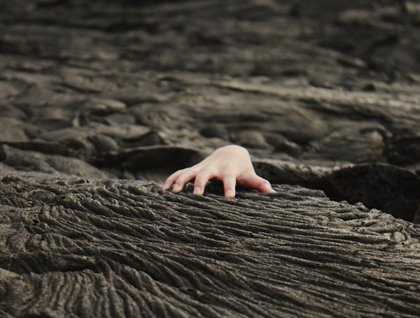After leaving civilization behind (the town of Puerto Ayora), we navigated towards Chinese Hat, situated off the coast of Santiago Island. Some of our guests were awake early in the morning and with luck got to see a group of 7 greater flamingos flying over the surface of the ocean.
After breakfast, we started our day with a Zodiac ride along a young lava flow from 1897. The ocean was clear and calm and we could see several species of fish from the Zodiac. Although the landscape was lovely and dramatic, our main goal was to find some Galapagos penguins. We certainly found about three Galapagos penguins fishing for small bait fish along the coast and some blue footed boobies were fishing as well.
Along the ride we got to see spotted eagle rays mating in front of our Zodiac and got to photograph this uncommon encounter. We soon got ready for snorkeling and jumped in the water. Below the surface the story is completely different; all sorts of fish swimming in schools while white tip reef sharks were sleeping on the bottom, eagle rays were searching the sandy areas, lobsters and puffers were hiding under the rocks and penguins were swimming right next to us! It was like they had all decided to come out and greet us. Even the sun was out giving us great visibility. It could have not been a better snorkeling outing!
During the afternoon, were taught our younger explorers how to drive a Zodiac (they had a blast!). And soon enough we got ready to land in Sullivan Bay and transport ourselves back in time (1897 to be exact). A vast open space of black basaltic lava expanded its territory all the way to the horizon. This was like imagining the old Galapagos with its first pioneer species struggling for survival and adapting to the dry environment that the place offered. The moonscape was full of rustiness from the iron and air bubbles from when the gasses found their way out of the lava. Nature doesn’t give a second chance, so everything here had to fight for survival. It was breathtaking, barren and dramatic but fascinating at the same time! Red cinder cones were standing in the far distance, isolated by the black lava that flowed around them. They contrast the landscape and give the place a tone of age difference between old red and young black lava. Three out of the 7 endemic genuses of plants to the Galapagos can be found at this visitor site. They are scalesia (endemic daisy-like bushes), brachycereus (endemic lava cactus) and jasminocereus (candelabra cactus).
There is nothing better than a tasty afternoon mixed with the flavors of Biology and Geology together on the National Geographic Islander.









